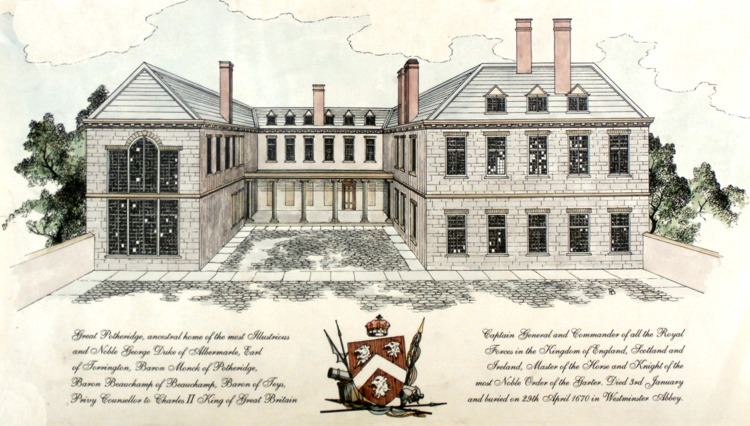 | ||
2014 ndas little potheridge dig video
Potheridge (alias Poderigge, Poderidge, Powdrich, etc.), in the parish of Merton, in the historic hundred of Shebbear, 3 miles south-east of Great Torrington, Devon, England, is a former Domesday Book estate and the site of the former grand mansion house re-built by George Monck, 1st Duke of Albemarle (1608–1700) circa 1660 on the site of the former manor house occupied by his family since at the latest 1287. It was mostly demolished in 1734 after the death of the widow of his son Christopher Monck, 2nd Duke of Albemarle (died 1688) and the surviving section forms the present Great Potheridge farmhouse, a Grade I listed building, inside which however some remnants of the former mansion remain, including a grand staircase, two massive 17th-century classical-style doorcases and a colossal relief-sculpted wooden overmantel. The latter depicts within a wreath of flowers, against a background of an elaborate antique trophy of arms, five putti, two of which, in flight, hold between them a crown, an allusion to Monck's central role in the Restoration of the Monarchy. The chapel "of Grecian architecture", i.e. classical, was in ruins in 1770 and was almost entirely demolished before 1822, with only the west wall left standing. In 1879 the stables, however, were still standing and were said to "give the visitor some idea of the magnificence of the ancient building". In 2014 Great Potheridge with 6 acres of land remaining of the former estate is used as an outdoor activity centre for young people operated by Encompass Training. It is today known as "Great Potheridge" to distinguish it from the nearby house, formerly on the estate, known as "Little Potheridge".
Contents
- 2014 ndas little potheridge dig video
- 2014 ndas little potheridge dig short summary
- Domesday Book
- de Estaneston
- Monk
- Granville
- Leveson Gower
- Rolle
- References
2014 ndas little potheridge dig short summary
Domesday Book
In the Domesday Book of 1086 the estate of Porrige (Potheridge) was listed as the 36th of the 176 Devonshire holdings of Baldwin de Moels, Sheriff of Devon. His tenant was Alberi (Aubrey), who also held from him the estates of Stockleigh and Woolladon, both also in today's Meeth parish. The tenant prior to the Norman Conquest was Ulf.
de Estaneston
Later as recorded in the Book of Fees it was held from the feudal barony of Okehampton by Ralph de Estaneston.
Monk
According to the Devon antiquarian Sir William Pole (died 1635), Potheridge was the residence of the family of Monk (alias Monke, Monck, etc.) since at the latest 1287. The family was recorded in ancient Norman-French charters as le Moigne (modern French le moine, "the monk") or de Moigne and was Latinized as Monachus, from ancient Greek μοναχός (monachos), "single, solitary" and Anglicised as "Monk", or "Monck". According to Tristram Risdon (died 1640) in about 1216 Roger le Moyney held one fee in the Devon parish of West Anstey and was succeeded by William le Moyney. As recorded in the Book of Fees William le Moigne and Roger le Moyne held land in West Anstey from Ralph de Champeus who held from the feudal barony of Barnstaple. The family is memorialised by today's "Money Common" in that parish. Another part of Anstey was held by the feudal barony of Okehampton. The descent of the family of "Monk of Potheridge" is given as follows in the Heraldic Visitation of Devon:
Granville
The ancient Grenville family (later modernised to Granville), lords of the manors of Bideford in Devon and Stowe in Cornwall, was earliest related to the Monk family through Honor Grenville (c. 1493/5-1566), wife of Arthur Plantagenet, 1st Viscount Lisle (died 1542), KG, and mother of Frances Plantagenet, wife of Thomas Monk of Potheridge. Thomas's great-grandsons renewed the kinship to the Grenvilles through their mother Elizabeth Smith, half-sister of Grace Smith, the wife of Sir Bevil Grenville. The 1st Earl of Bath fixed the spelling of the family name to "Granville".
Leveson-Gower
The Leveson-Gower family, having inherited Potheridge, quickly sold it to the Rolle family of Stevenstone, great landowners in Devon. They did not however forget their Granville inheritance, and memorialised it in subsequent names and titles: Jane Granville's great-grandson was Granville Leveson-Gower, 1st Marquess of Stafford (1721–1803) one of whose younger sons was Granville Leveson-Gower, 1st Earl Granville (1773–1846) (younger half-brother of George Leveson-Gower, 1st Duke of Sutherland (1758–1833)), whose son was Granville Leveson-Gower, 2nd Earl Granville (1815–1891), Secretary of State for Foreign Affairs.
Rolle
Potheridge was acquired from the Leveson-Gower family by the Rolle family of nearby Stevenstone and of Bicton in South Devon. In 1850 it was held by the trustees of John Rolle, 1st Baron Rolle (c. 1750 – 1842) for the benefit of his adoptive heir Hon. Mark Rolle (1835–1907) (born Mark George Kerr Trefusis), a younger son of Charles Rodolph Trefusis, 19th Baron Clinton (1791–1866) of Heanton Satchville, Huish, the parish adjoining Merton on the south. Mark Rolle was the largest private landowner in Devon, according to the Return of Owners of Land, 1873, being the beneficial owner under the trustees of Lord Rolle's will of over 55,000 acres. The 19th Lord Clinton was lord of the manor of Merton in 1850, having inherited it with other estates from the Rolle family of Heanton Satchville, Petrockstowe, and his grandson (Mark Rolle's nephew) Charles John Robert Hepburn-Stuart-Forbes-Trefusis, 21st Baron Clinton (1863–1957) was Mark Rolle's heir and in 1947 leased his principal seat of Bicton for use as the Bicton College of Agriculture, and in 1952 Great Potheridge was being used as part of the campus buildings of Bicton College, situated some 40 miles south-east of Potheridge near the south coast of Devon. In 1968 the tenant of Clinton Devon Estates at Potheridge was Mr C.W. Lewis, a breeder of Devon cattle who farmed 500 acres.
